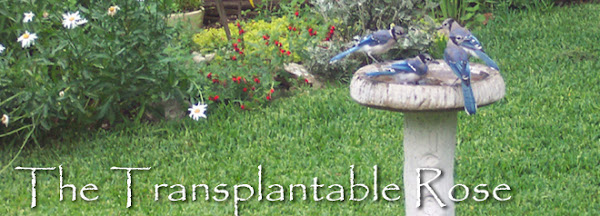The days are still warm here in Austin, but the nights are finally cooling down. La Nina has kept us very dry - the 12-inches of rain from Hermine came fast and left fast and were not part of a weather pattern... more of a weather event. Handwatering and milder weather have made some plants happy; tall trees and lower sun angles combine to make other plants stall from lack of light.
At this time of year the partially sunny front yard has flowers that equal the shadier back yard bunch so on our once-a-month Garden Bloggers Bloom Day quest for what's in flower we should check there first.
The Lycoris radiata/Red spider lilies from the previous post appear to be making seeds now.
 This group is nestled into the front butterfly bed, a large oval border that was made by The Divas of the Dirt in 2008, on the spot where an Arizona Ash once grew. The imminent demise of that large tree inspired me to write the song in the sidebar.
This group is nestled into the front butterfly bed, a large oval border that was made by The Divas of the Dirt in 2008, on the spot where an Arizona Ash once grew. The imminent demise of that large tree inspired me to write the song in the sidebar. Purple Lantana, Gregg's Mistflower, Blackfoot Daisies, Bengal Tiger Cannas, Black & Blue Salvia, Salvia Nuevo Leon, seedlings of White Gaura, self-seeded Pink Gaura, young plants of yellow-flowered Damianita and a large Rosa mutabilis are in full bloom. On the street side a Forsythia sage/Salvia madrensis struggles to become established... it's half the size expected, but the buds promise blooms later this week
Purple Lantana, Gregg's Mistflower, Blackfoot Daisies, Bengal Tiger Cannas, Black & Blue Salvia, Salvia Nuevo Leon, seedlings of White Gaura, self-seeded Pink Gaura, young plants of yellow-flowered Damianita and a large Rosa mutabilis are in full bloom. On the street side a Forsythia sage/Salvia madrensis struggles to become established... it's half the size expected, but the buds promise blooms later this week Those are Blackfoot Daisies around the salvia - more of them brighten the parking strip to the west of the butterfly bed. They like good drainage and sun so until these two beds were made I didn't have much success with this pretty little evergreen native flower. Blackfoot daisies have a very pleasant scent if there are enough flowers open at one time and a swath like this can stop you in your tracks when you stroll down the sidewalk.
Those are Blackfoot Daisies around the salvia - more of them brighten the parking strip to the west of the butterfly bed. They like good drainage and sun so until these two beds were made I didn't have much success with this pretty little evergreen native flower. Blackfoot daisies have a very pleasant scent if there are enough flowers open at one time and a swath like this can stop you in your tracks when you stroll down the sidewalk. 
This parking strip garden was the 2009 Divas of the Dirt project - a year later the Gulf Muhly grass is so fabulous in bloom that the failure of the Mexican Feather grass isn't even noticed.
 On the South side of the birdbath the Mutabilis Rose is really well established - it was pruned in late summer but is filling out fast.
On the South side of the birdbath the Mutabilis Rose is really well established - it was pruned in late summer but is filling out fast. In the Pink Entrance Garden on the North side of the drive 'Belinda's Dream' rose has a new flush of bloom, combined here with a no-name, rosy-colored gaura that was planted in February 2007.
In the Pink Entrance Garden on the North side of the drive 'Belinda's Dream' rose has a new flush of bloom, combined here with a no-name, rosy-colored gaura that was planted in February 2007. In back the brightest color comes from Orange cosmos. The first sowing produced enormous plants by mid-summer. Those plants died but new seedlings are now blooming, backed up by a blazing Pineapple sage/Salvia elegans in the hummingbird border.
In back the brightest color comes from Orange cosmos. The first sowing produced enormous plants by mid-summer. Those plants died but new seedlings are now blooming, backed up by a blazing Pineapple sage/Salvia elegans in the hummingbird border.
The previous post had photos of Scutellaria indica 'Dorota Blue', White ginger, Sweet Olive/Osmanthus fragrans and a video clip of Salvia vanhouttei, all still blooming. This time we'll look at a Firecracker plant - probably Russelia equisetiformis, a Passalong plant from my friend Ellen.
 Now check out the Aster frikartii blooming behind the dwarf Greek myrtle. Why is it blooming back there, you ask? Why isn't it out where it can be seen?
Now check out the Aster frikartii blooming behind the dwarf Greek myrtle. Why is it blooming back there, you ask? Why isn't it out where it can be seen?Because this is the one that bloomed - the other two had more light and air, but have become tiny non-flowering remnants of what they once were.

The 'Julia Child' rose has flowers again - the new foliage looks pretty good but the older leaves show how insects have damaged it. These holes are round, so perhaps this is the work of leaf-cutting bees.

Here's the first flower on the Philippine violet. The plant is alive, but it had a bad year, reaching only 1/3 of its usual size.
 I bought a large Malvaviscus 'Pam Puryear', AKA 'Pam's Pink' Turkscap in late spring. You might also hear it called Wax Mallow I'm not sure this variety will be hardy in my garden and after seeing Trisha Shirey's flower-laden Turkscap plants on Pam/Digging's blog wonder if it wants more sun to bloom well, but at least I've seen a few lovely flowers.
I bought a large Malvaviscus 'Pam Puryear', AKA 'Pam's Pink' Turkscap in late spring. You might also hear it called Wax Mallow I'm not sure this variety will be hardy in my garden and after seeing Trisha Shirey's flower-laden Turkscap plants on Pam/Digging's blog wonder if it wants more sun to bloom well, but at least I've seen a few lovely flowers.
The white form of Turkscap-Waxmallow is blooming, too - but its leaves are tattered.

Mr Brown Thumb's post on the difference between Cardinal vine and Cypress Vine made me realize that Cypress vine is such a great reseeder its presence is taken for granted in my garden. Cypress Vine bloomed each year at our first Austin house and returns every year at this one, pleasing the hummingbirds, sending thousands of seeds out to sprout and be weeded out and growing into green, ferny blobs of foliage that can derail planned traffic patterns.

When they run out of support they twine together and make enchanting patterns against the sky

But Ipomoea quamoclit seldom gets photo space on my blog so to make up for that, here are the star-shaped, pure red flowers of the Cypress Vine

I'll leave you with the latest Moonflower Vine/Ipomoea alba photo. As long as it keeps blooming, I'll keep taking its picture.
 This is the main post for May Dreams Carol's Bloom day event - head over to her blog to check out more than 100 other GBBD posts. To find an additional comprehensive list of everything blooming in my garden with botanical names look at the companion blog to the Transplantable Rose, Annie's Addendum. Happy GBBD from Annie in Austin
This is the main post for May Dreams Carol's Bloom day event - head over to her blog to check out more than 100 other GBBD posts. To find an additional comprehensive list of everything blooming in my garden with botanical names look at the companion blog to the Transplantable Rose, Annie's Addendum. Happy GBBD from Annie in Austin









































